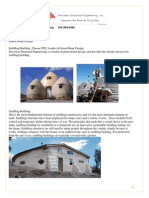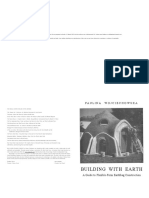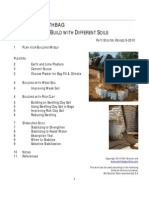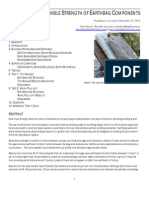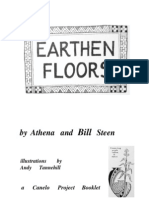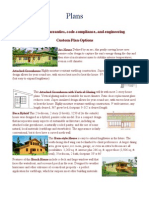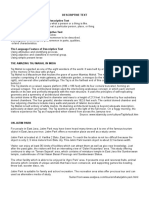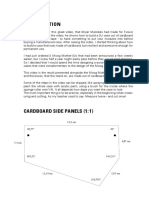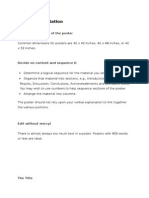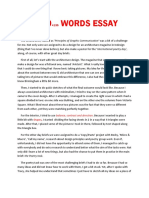Earthbag Building in The Humid Tropics, 2nd Ed.
Uploaded by
Patti StouterEarthbag Building in The Humid Tropics, 2nd Ed.
Uploaded by
Patti Stouter1
Earthbag Building in the Humid Tropics
Earthbag Building in the Humid Tropics: Simple Structures
2nd edition Patti Stouter
June 2011 Online version available at www.EarthbagBuilding.com and at www.Scribd.com/patti_stouter. Please share these free self-help guidelines and let us know how to improve them.
Earthbag Building in the Humid Tropics
TABLE OF CONTENTS
3 5 7 11 About Earthbag Types of Earthbag Raw Earth Versus Cement Exterior Finishes
STEP BY STEP: GENERAL PRINCIPLES
14 15 Soil Tests Materials
LAYOUTS FOR NON-HAZARDOUS AREAS
16 17 18 19 20 Buttress Corners Piers at Corners, Straight Walls Circles, Corrugated Walls, Wall Height & Thickness Window & Door Openings, Window & Door Sizes, Windows without Arches Roof
INSTRUCTIONS
20 22 24 26 25 28 29 Placing Bags Base Course, Openings Bond Beam, Roof, Floor Finishes A Note About Working Across Cultures Acknowledgements, About the Author, Bibliography
Earthbag Building in the Humid Tropics
In many parts of the world buildings must be extra strong for earthquakes or hurricanes and tsunamis. Other publications can help you plan for this.1 West Africa, northeastern South America and some parts of China and India do not have many earthquakes. Check the global seismic hazard assessment program (GSHAP) maps to be sure that your area is not at risk for earthquakes. If you live far enough inland where cyclones are not strong and tsunamis can't reach, these guidelines can help you try a new way of building simple structures with earth. Your buildings must resist termites and mold as well as be right for the climate, and for how people live. Ideas for locating and shaping your building to be comfortable are in Shaping Buildings for the Humid Tropics, and examples of simple buildings are in Simple Earth Buildings for the Humid Tropics, both at www.EarthbagBuilding.com.
ABOUT EARTHBAG
Unlike other earth techniques, a wide range of soil types can be used to build with earthbag. Used bags from plaster, grains, or cement are available around the world, and also mesh tubes used for vegetable packaging. Because the bags or tubes are light, they can be transported easily for building in remote areas. Above: Earthbag construction for a US National Park. Left: An earthbag home in South Africa. Earthbags don't deplete scarce local resources, like wood or brick buildings do. Bags and barbed wire form a very small percentage of an earthbag wall. Most of the material used is local, natural subsoil. Thus earthbag buildings have a very low carbon footprint.
1
Earthbag can be reinforced for the highest seismic risk areas in a similar way to other masonry. Nabil Taha of PSE recommends a system of twinned exterior rebar in a cement stucco; http://www.structure1.com/html/earthbag11.htm It may be possible after more testing to reliably reinforce earthbag in less expensive ways. The ebook Build to Resist Hazards at http://www.scribd.com/doc/29931428/Build-to-Resist-Hazards-Construire-Pour-Resister-aux-Dangers illustrates reinforcement techniques and discusses structural issues of earthbag in more detail, although it needs updating. Watch for a new book in the planning stages called Earthbag Building Design. For architects and engineer, the ASTM recommends the New Zealand Standards for Earth Building. Current tests are planned to compare the strength of earthbag to adobe, to be able to adjust the NZ performance-based guidelines for earthbag. Watch the Earthbag Building Blog for recent news or email me at simple_earth@yahoo.com. Other helpful information about building with earth in seismic risk regions or tsunami-prone settings are: Minke, Gernot (2001). Construction Manual for Earthquake Resistant Houses Built of Earth. Eschborn, Germany: GATE-BASIN at www.basin.info/publications/books/manualminke.pdf; Geiger, Owen (2008). Post-Tsunami Affordable Housing Project. Available at www.earthbagbuilding.com/articles.htm
4 Earthbags can be shaped into traditional walls that resemble standard masonry. Careful work can create beautiful structures with minimal costs. Walls are tamped with hand tools, and when dry become as strong as or stronger than cob or adobe walls. Bags are covered with plaster to make a permanent wall. Right: Graceful shelter in Colorado, US.
Earthbag Building in the Humid Tropics
Standard earthbag walls combine the thermal properties of fired and stabilized masonry, with excellent performance in humidity. Highly insulated walls can also be made where there are naturally occurring lightweight fills. Earthbag goes up relatively quickly and is very easy to learn. Preparing soil, filling, placing, and tamping do not require special strength or skills. Just how long do earthbags take? Three unskilled people take about an hour to lay 12 square feet of earthbag wall. An experienced single person who does not have to mix soil may be able to build 5- 10 square feet of wall in an hour. Using light weight fill, one person can lay up to 14 square feet in an hour. So if a single person is building a 10 x 10 room, working 40 hours each week, it could take between 2 and 4 weeks to build. With lightweight fill, an experienced person may need less than 2 weeks. Tubes would be a little quicker, and mesh tubes more so if no barbed wire is needed. Mixing soil, forming many windows or doors, and measuring complex shapes all increase time needed to build. Earthbags can be filled with a variety of earth materials. Most soils solidify when placed and tamped. For humid climates, fills that set solid will ensure continuing strength under simple clay finishes, even if bags or tubes eventually decay. It is easy to prepare subsoil for earthbag walls by digging to loosen it, raking large stones out, and breaking up big clods. Topsoil, leaf mold, or many roots or sticks should not be used in the fill mixture. 10- 30% clay keeps the wall together once it has dried, but less clay may still be workable in solid weave bags or tubes, depending on the type. Fill material is tested by moistening it, filling a bag, tamping it, and drying for a week or two. It should be strong enough to hold an 8 cm (3) nail securely, free of major cracks. It should also be able to hold a 54 kg (120 pound) person while spanning 25 cm (10). Right: A round Thai earth block room.
Earthbag Building in the Humid Tropics
The properties that allow curving brick walls to be built of a single width of brick without reinforcing make curving earthbag walls strong. Earthbag domes were proven strong enough for Californias worst seismic risk zone by Cal-Earth. Curving walls are common in traditional buildings. In many parts of Africa the roundhouse is a standard shape where concrete block has not replaced it with rectangular forms. Round building walls use less material and labor for the same interior space. In cool climates, they lose less heat than rectangular rooms. And rounded rooms are always perceived as being larger than the same size rectangular room.2 Left: Next Aid earthbag performance building. But straight earthbag walls can also function well. Many cultures prefer straight walls, and in warm climates straight walls provide more surface area for windows and vents. For straight earthbag walls, small interlocked piers spaced 4 m (13) apart along a wall can give it side to side stability.3 Testing in an engineering laboratory at Queens University in Canada showed that earthbags resisted almost ten times as much compressive force as conventional wood stud framing, per wall length. The un-plastered polypropylene earthbags were filled with dry gravel or wetted and tamped sandy soil.4 Straight-walled buildings of loose sand in Eternally Solars special channeled bags5 were strong enough for building in South Africa without any metal reinforcement.
Types of Earthbag
Earthbag is developing into a complex family of related materials. Fills can be loose, clayrich earth, stabilized earth or sand. The bag can be solid-weave or mesh, tube or bag. Each type has its special strengths and limitations. Further testing will more fully reveal the exact structural differences between different bag and fill choices6. Guidelines are needed for un-reinforced buildings, partially reinforced, as well as the fully-reinforced buildings needed in high seismic risk areas. But earthbag structures in at least 40 countries have already performed well. Earthen fill containing clay is the original earthbag or Superadobe in bags or tubes. Tubes
2 Smith, Michael. 'Cob' in Elizabeth, Lynne and Adams, Cassandra (2005). Alternative Construction. NY: Wiley, p. 123 3 Hunter, Kaki and Kiffmeyer, Donald (2004). Earthbag Building. Gabriola Island, BC, Canada: New Society, p. 38 4 Daigle, Bryan C. (2008). Earthbag Housing. Ontario,Canada: Queen's University, p. 119 5 See information provided by Johnny Anderton at http://www.earthbagbuild.com/ 6 Check Kelly Harts Testing page for new developments at http://www.earthbagbuilding.com/testing.htm
Earthbag Building in the Humid Tropics
are quicker to build, but individual bags may provide more vibration dampening in earthquakes. Clay must be avoided or stabilized in flood-prone areas. Gravel or rubble fill should be placed in doubled solid weave bags. Angular gravel, including light weight and insulating scoria or pumice, can form a stable bag fill. Truly loose fills like sand are used only in solidweave individual bags. Sand will require bags kept in good condition, and either exterior stress skin reinforcement, or special channeled bags to resist tendencies towards slumping. Some loose fills using organic materials for insulation, like rice hulls, are experimental. Stabilized fills are subsoil that includes a proportion of lime, Portland cement, or fly ash that sets and hardens after bags or tubes are placed. A new alternative for stabilized fill is cast stone made like the pyramids out of crushed rock with washing soda or other ingredients7. Mesh bags or tubes used in hyperadobe cling well to the course below, reducing the need for barbed wire in low risk regions. But because mesh bags do not produce as high compression within the bags during tamping, they should be used with fills that contain more clay than those required for solid weave bags, or with stabilized fills. Below: Earthbag construction in the Philippines. Loose fill materials rely on bags for strength, but can form stable, long-lived buildings. Oil soaked sandbags used to make trenches during World War 1 are still standing almost 100 years later.8 Plastic feed bags may last 500 years, because they need ultraviolet light to break them down. polymers such as polypropylene and polyethylene resist biodegradation [by microbes] totally.9 Protected from sun by plaster, and combined with galvanized barbed wire, an earthbag wall has a strong internal matrix that adds tensile strength to the great compressive strength of earth. Engineers use fabrics like these in many ways. Geo-synthetics10 now repair eroding hillsides, stream banks, and stabilize steep slopes cut into earth. These are often stronger and provide more permanent solutions than the rigid structures preferred in the past. Earthbag walls are strong enough to form arches without concrete over openings up to 1.2 m (4) wide, as long as openings are spaced at least 1 m (3) from corners or other openings.
7
See Owen Geigers new geopolymer blog at http://geopolymerhouses.wordpress.com/ 8 Kennedy, Joseph F. and Wojciechowska, Paulina. 'Earthbag' in Elizabeth (2005) p. 177 9 Woodings, Calvin (undated). 'New Developments in Biodegradable Nonwovens'. New Fibers. Retrieved 10-24-2008 from www.technica.net/NF/NF3/biodegradable.htm 10 Geo-Synthetics Magazine is available at http://geosyntheticsmagazine.com/
Earthbag Building in the Humid Tropics
It is difficult to add openings into an existing earthbag wall. With some advance planning, an extra arch can be easily formed in a new wall where a door or window might be wanted in future. If filled with separate earthbags that are not woven into the running bond pattern, these can be easily removed in the future. Left: An arched Mexican earthbag building. Larger spans and closer openings can also be created with cement stabilized earthbags. Kelly Hart witnessed the strength of a dome covered with a paper and cement mixture that was very difficult to dismantle.11 In earthbag structures of wiremesh reinforced cement plaster the tensile strength of the mesh, bags, and barbed wire can produce buildings much stronger than required by building codes for earthquake hazard areas.
Raw Earth versus Cement
How permanent is earth? Exterior walls of mud block or cob protected by overhangs and dry base courses with exterior-type clay finishes have lasted for hundreds of years. A majority of the buildings in many parts of Europe are actually made of raw (unstabilized) earth, many of them 200- 500 years old. Large, historic structures of earth still stand all over the world, including pyramids in Mexico, China's Great Wall, and five-story apartments in Yemen. Depending on where you live, some objections to the use of raw earth may need to be answered. Finding other new buildings in the region made of earth would be helpful, but there are also many examples of attractive projects on the internet.12 Older earth buildings that have not been mistreated can be visited. Earth walls are not flammable, and insects or rodents cannot live in them if they are solid.13 Tamped earthen walls are not easy for thieves to break through, and earthbag walls stop bullets. They are relatively cool and mold-free.14 In addition, raw earth walls purify interior air by removing pollutants.
11 12 13 14
Both tests are available at www.earthbagbuilding.com/tests.htm Examples are available at many earthbag sites, including www.earthbagbuilding.com/projects.htm Minke, Gernot (2006). Earth Building. Basel, Germany: Birkhauser, p. 18 For a full discussion of R-values and performance: Stouter, Patti (2008). Shaping Buildings for the Humid Tropics. Available at www.earthbagbuilding.com/articles.htm
Earthbag Building in the Humid Tropics
Earth walls must be built on a dry base, and given an overhanging roof. In regions with frost they also require plasters like lime that will allow the wall to dry out after storms. Most earth building failures result from water damaging lower plasters and eventually under-cutting the base of a wall. This can easily be prevented in earthbag construction with gravel or sand bag foundation walls covered with cement stucco. Stone or tile veneer can also be used to face foundation walls without cement. Right: Earth needs good boots and hat Simply because this generation thinks of concrete as safe and strong, it routinely adds cement or other expensive stabilizers to earth buildings that do not require it.15 Ordinary small houses can easily be built strong enough with little or no cement or bitumen. Tests have shown that a careful balancing of the range of particle sizes in a soil may improve strength more than added cement. Some soils become weaker with the addition of certain proportions of Portland cement. Some clay soils can be stabilized with lime alone, others with lime and a much smaller amount of cement.16 Above: Un-necessary concrete and wood posts were required by the building department on Utahs first code-approved earthbag building. Rammed earth walls do not require chemical stabilizers. If soil mixes containing clay are chosen carefully, because of their intense tamping, they will not erode in rainfall. Earthbags share some of the properties of rammed earth. Soil masses become stronger as clay particles align with better mixing or kneading or under repeated tamping as happens in earthbag and rammed earth construction. CEBs have been considered stronger and more water-resistant because they are compressed. But the particles of CEBs are not able to align for strength in the press because their compression is a single force instead of a series of blows.17 Unstabilized CEBs have also been known to 'blossom' or expand when they absorb enough moisture.
15 Houben, Hugo and Guillaud, Hubert (1994), transl. A. Gompers, J. Schilderman. Earth Construction. Intermediate Technology Publications, pp. 74 16 Minke (2006), p. 45 17 Minke (2006), pp. 44- 45
Earthbag Building in the Humid Tropics Julius Nyerere of Tanzania called cement 'European soil'. The widespread addiction to it is 'a kind of mental paralysis'. This material has surely increased the numbers of those without shelter by preventing earth building technology from being transmitted and improved. In Europe or America a worker can buy ten bags of cement with one day's wages. In many developing countries many days' work is needed to buy a single bag. To raise the cash someone must leave the village to earn a wage, damaging families and local economies. 18 Left: Concrete buildings in Yaounde, Cameroon.
We have shown the world the cement buildings that we like, and they have forgotten how to build with what is nearby and beautiful. Wise builders can begin to reverse this trend. Earthen materials of many kinds have passed stringent tests. They are better suited for construction than concrete in many ways. If we restore the reputation of earthen buildings, those who cannot afford concrete buildings will again be able to build for themselves, beautifully and with pride. Earthbag fills seldom need additives to give extra strength. To resist water damage lime alone, or lime and cement, or bitumen should be chosen in the smallest effective proportion by testing the soil. But for most buildings no stabilization is needed. Right: Laying bags in Haiti.
Reinforcing Earthbag
Wire and rebar are important to make most earthbag walls stronger. Barbed wire placed between courses of bags adds tensile strength and prevents horizontal shearing between layers. Strips or pins of wire mesh can also be used between courses. Since barbed wire is galvanized for outdoor use, it should last well in earthbag walls. The steady naturally-limited humidity levels of solid adobe walls have preserved wood as well as metal elements like ordinary non-galvanized nails for more than a hundred years.19
18 Bourgeois, Jean-Louis. 'Speaking the Vernacular: Mud versus Money in Africa, Asia, and the US Southwest' in Kennedy, Joseph F., ed. (2004). Building Without Borders. Gabriola Island, BC, Canada: New Society, p. 39 19 Minke (2006), pp. 14- 15
10
Earthbag Building in the Humid Tropics
Simple earthbag buildings may survive without wire; buildings of mud block and cob have stood for years, relying by shape and dimensions on the compressive strength of earth. Ordinary sandbags stacked 1 m (3') high in long straight walls withstand the great horizontal pressures of floods without slipping between layers.20 But because many structures include shapes and dimensions that add tensile stresses to walls, barbed wire is always recommended. Solid-weave poly bags have only moderate friction between courses. The greater friction of metal barbs buried in bags and cured earth can add significant stability, especially at vulnerable locations like corners and wall portions above windows. The tensile strength of barbed wire provides a welcome margin of error that may resist wall damage even if footings settle or localized mistakes in running bond, fill moisture, or opening spacings occurred. Above: Wooden window jambs in earthbag walls. Left: Barbed wire on gravel bags built during freezing weather Barbed wire also helps strengthen the wall during the construction process before it is fully cured. It can reduce the chance that bags may shift or be moved by unusually strong winds while the wall is still somewhat soft, and not yet tied together at the top with a strong bond beam. Two strands of barbed wire are standard with solidweave poly bags or tubes. These are critical for strength in any dome structure. They may not be as necessary with mesh bags or tubes in verticalwall buildings, but builders may want to add a single strand each course or every other course to increase cohesion of the wall under accidental twisting forces. Steel reinforcing rod or rebar can also be very helpful to reinforce earthbag buildings. Pins 60 cm (24 inches) long are used to attach upper bags to bond beams. Right: Hammering rebar into bag walls.
20 Retrieved 10-24-2008 from Sand Bag Express Web site at sandbagexpress.com/filling
11
Earthbag Building in the Humid Tropics Right: Corner buttresses in Costa Rica.
Like traditional adobe, earthbag can be built with buttresses or piers extending outward at all corners, and near door openings. But many builders prefer to drive a length of rebar vertically through the wall instead of taking space and labor for corner piers.
Exterior Finishes
Exterior earth walls can be protected from erosion by rain with specialized clay coatings. Additives include various animal products, ash, and the milky saps of certain plants. Oil mixtures are also often used successfully. Each soil reacts differently to additives. It may be wise to ask about old building techniques, and additives available for free or at low cost. Lime plasters have been the standard on older earth buildings in many parts of the world. They can be applied over earthen base coats. Lime plasters slowly harden by extracting carbon dioxide from the atmosphere. They need some maintenance every year or two. But unlike Portland cement stuccos, thin layers of lime bonds well to lower layers, and lime wash can actually fill in cracks over time. Right: Applying earthen plaster. Tile or natural stones inlaid on earth plaster can be used to protect exterior earthen walls in heavy rainfall areas. Only the lowest part of an exterior wall covered by a good roof overhang is frequently rained on, so lower wall portions can receive special tile or stone treatment while upper portions are simply plastered with water-repellent clay. Cement stucco is not good for earthen buildings in areas that freeze. The concrete absorbs water, but dries out very slowly. Raw earth construction absorbs water more quickly, but also dries more quickly. A concrete covering prevents the earth from drying out, and wicks water to the earth structure, keeping it soggy21. Although concrete plaster is tempting, Spanish mission buildings in the US southwest have been damaged by cement coatings. Moisture built up behind the walls and the adobe literally melted away leaving a shell of cement. The building looked fine from the outside, but actually dissolved away. It was a huge disaster that's still being dealt with.22 Cement stucco can be used on gravel or sand bags, or on bags containing stabilized earthen
21 Hunter and Kiffmeyer (2004), p. 59 22 Owen Geiger, email to the author 10-23-2008
12
Earthbag Building in the Humid Tropics
fill, in freezing climates. It has also been used on sand-rich earthen fills in frost free regions. The cost and time to repaint moldy cement surfaces every few years should be considered. Where low cost is important, time-tested earthen plaster is more than adequate. For interior finishes, earthen plasters are becoming desirable among those seeking chemical-free housing and natural beauty. Often lime plaster or linseed oil finishes on earthen plasters are used for the lower 1- 1.3 m (3- 4) of walls that will be wiped more frequently to clean them. Left: Colorful earthen plasters. For areas with water use like kitchens and bathrooms, glazed tiles can be inlaid with earthen mortar on earth walls. Concrete grout can be used if necessary, because it results in only a small proportion of cement materials in contact with the wall surface. Right: A finished building in Haiti with raised and painted details.
13
Earthbag Building in the Humid Tropics
STEP BY STEP: Suggestions for Building with Earthbag in Humid Areas
One way to introduce a new construction technique like earthbag is to use it for a small structure, like a latrine, a guard booth in a privacy wall, or a materials storage area for the work site. If a small structure is finished attractively and experienced first-hand, it will be easy to see if earthbag is the right material for larger buildings, and then decide on materials and techniques. Right: Although not necessary, this backhoe made filling the upper levels easier
General principles:
Use as little wood or metal as possible, to avoid rot and termites. Use plan layouts that are stable, with curves or frequent piers or buttresses (see below). Make sure rainwater flows away from the bases of all walls. Place the building on a rise, or dig a swale around it. Slope earth down at least 2cm per meter for 4- 6m (1/4 inch per foot for 13- 20). Use a vapor barrier below the floor and between any concrete and earth. Provide a waterproof base course at least 60 cm high (2). Criss-cross bag courses at piers and corners. Wrap barbed wire around corners; overlap and locate breaks in the center of walls. Provide a wide roof overhang: at least 20 cm (8), but 1.5 m (5) is better. Use as much lightweight gravel as you can afford for cooler, less sweaty buildings, especially at the base of walls. Test exterior finishes to be sure theyll stand up to rains.
This booklet provides some basic advice for building with earthbags. Reading and taking courses from earthbag builders can be very helpful. More complete instructions are available in Owen Geigers 2011 Earthbag Building Guide, available as an e-book through the Earthbag Building website. The classic book Earthbag Building also contains many helpful ideas.
14
Earthbag Building in the Humid Tropics
Raw earthbag domes are not recommended as simple buildings in humid regions without a complete added roof. Domes lack the shade cast by roof overhangs, and tend to have rainfall soak into the ground right at the base of walls. A dome roof needs expensive waterproofing to prevent leaks (unless it is fully cement stabilized- an expensive step). Leaks more easily cause structural problems in a dome roof than in a wall. Domes can be retrofitted for humid climates by adding porches to shade walls. Porch roofs can keep rainfall away from building walls, and provide much-needed outdoor living space.
Soil Tests:
Ball test: Wet soil just enough to hold together. Form into 4 cm (1 1/2 inch) balls. Drop them from 1.5 m (5) height onto a hard surface. If they flatten only slightly the soil has too much clay and needs sand added. If the balls develop cracks, the soil is good for earthbag. If the balls break into 4 or 5 pieces the soil is good for earthbag (or adobes or rammed earth). If the balls shatter, the soil does not have enough moisture, or not enough clay.23 Right: Good builders learn the differences between soils. Below: A soil good for earthbag. Bag test: Break up clods, remove larger stones, and mix just enough water so that the mix leaks a little water through the fabric when the bag is tamped. Fill the bag and fasten the top snugly (no extra loose fabric). After tamping it should holds its shape if dropped. Fill several bags, some with additives mixed in. Tamp them, leave in the shade and protected from rain to dry for one to two weeks. When really dry, open the bags to check for cracks and shrinkage. Check for strength. It should hold a 7.5 cm (3) long nail without splitting. When you build with a subsoil that contains clay, use the ball test to check that the soil is moist enough. If the ball leaves a wet mark, let it dry out or add more dry soil. If it shatters when dropped, the mix needs more water. Only use mix that is the right moisture to fill bags. The strongest soils contain some gritty sand, and not too much clay or silt. If a soil lacks one of these, it can be added and mixed in. A little clay can easily be added to sandy soil by making a clay slip and stirring it in. Most soil is easy to adjust by spreading in thin layers and then stirring with a hoe to mix. But adding a little sand to a heavy clay soil is harder. The clay
23 Hunter and Kiffmeyer (2004), p. 23
15
Earthbag Building in the Humid Tropics
is hard to spread out, and people or animals may have to trample the sand into it. Soils with more than about 10% clay have to be kept dry under tarps to work with them easily. Soils that have a lot of silt are also hard to keep at the right moisture content; a little too much moisture and the bag will bounce and cant be tamped until its dried out for a day. Read the free e-book Soils for Earthbag: Part I Soil Testing for more information about soils.
Materials:
Bags or tubes:
43- 46 cm x 76 cm (17- 18 x 30) solid-weave polypropylene bags 43- 46 cm (17- 18) wide flat-weave tubes (turned inside out if a slippery finish) 50 cm (20) lay-flat raschel HDPE mesh tubes- fill 30 cm diameter (12) 43- 46 cm x 76 cm (17- 18 x 30) HDPE mesh bags of leno or raschel mesh Subsoil or light gravel for fill Clayey soil for plastering Gravel and/or sand for footing/ wall base 4 point barbed wire New polypropylene or nylon cord Galvanized flashing or diamond expanded metal lath for nailers Galvanized wire or nails Insulation for under the floor: pumice, scoria, glass bottles, or trash foams and small plastic bottles. Good quality vapor barrier for under floor and lower portion of wall Small amount of concrete for exterior plaster of lower wall portion
Layouts for Non-Hazardous Areas:
Buildings should be built in ways that will fit with what you think is attractive and convenient. These guidelines are to give you a choice of how to make earthbag walls strong without using steel or wood reinforcing. These design details are based on conventional adobe or mud block construction techniques. They are not appropriate for areas that are subject to hurricanes or tsunamis, or that are within earthquake hazard zones.
16
Earthbag Building in the Humid Tropics
Buttressed Corners:
Rectangular buildings that do not use any steel reinforcement should have a support buttress at least 1.2 m (4') high on one or both of the outside walls at square corners. Right: Always start at the buttress end so the bags crisscross correctly. Buttresses make it easier to add to the building in the future. For a buttress, the bags must alternate every course to fasten it into the wall very well. They must also be tied together firmly every 3 layers with strong cord that will not rot. If the buttress is straight up and down, it should stick out from the wall at least 60 cm (2'). The buttress could start out a little wider, and step back as it goes up, or it could slope gently into the wall. Left: Buttresses stepped and sloped. Below: A single angled buttress works well but needs odd-shaped earthbags.
17
Earthbag Building in the Humid Tropics
Piers at Corners:
A single pier may be less work than two projecting buttresses. It also does not take up as much room. Because the supports are made a part of a thickened wall, it only has to jut out as far as the width of one bag. Barbed wire and extra cord or plastic straps should be used to hold this together firmly. If steel is available, a single rebar pounded down through the corner is enough without adding a buttress. Hammer a 1.5 m (5') long piece into the top near the corner when the wall is 1.35 m (4'6") high. Hammer in a second rebar at the same location when the wall is 2.5m (8') high. Right: First 3 courses of a corner pier.
Straight Walls:
When any straight piece of outside wall is 4m (13') long or longer it needs a pier. If it has an intersecting wall inside that is built at the same time, this can work like a pier. It must be fastened firmly into the outside wall by alternating layers and connecting barbed wire or strong cord. Right: Straight walls need piers. Walls can have straight sections up to 6- 7.5m long (18- 24') or longer between sturdy intersections or piers, but may need some bracing inside until they dry. A stub wall sticks out from the main building. If it is 1.5 m (5) or more it should have a bench or pier or buttress to brace it.
18
Earthbag Building in the Humid Tropics
Circles:
An appropriately sized round wall does not need piers or buttresses to support it. If the radius is between 5 m (or 16') and 1 m (or 3') it will not need a pier or buttress. A full circle is a very strong shape, up to a 5m (16') radius. A circle larger than 10 m (32) across inside will need some piers. Some people build 3 or 4 circles for rooms at the outside corners, and let them hold up one large roof between them. Right: Thai adobe buildings.
Corrugated Walls:
Instead of curving or having piers, straight walls 4m (13'). The nooks within the wall can be used for storage areas bins or shelves or seats. It may allow the house to have a simpler shape than one with piers and buttresses sticking out. Left: Laurie Baker called this arrangement 'corrugated walls'.
Wall Height and Thickness:
Un-reinforced earthbag walls should be less than ten times as high as they are thick. For thin 38cm (15 inch) walls, 3m (10') is maximum height. The upper third of a wall could be built of smaller bags than the base if it has bracing piers or intersecting walls every 3m (10'). If a building needs to sit on a retaining wall and the total wall must be higher than 3m (10), the lowest portion should be made thicker. Larger bags can be used, or a two rows beneath the floor level. This is only for small structures, and would need a reinforced concrete grade beam at the floor level and a strong bond beam on top of the wall. The bond beam must be 15cm (6 inches) high and at least 25 cm (10 inches) wide.
19
Earthbag Building in the Humid Tropics
Window and Door Openings:
Openings should be at least 1m (3') from corners, or 50 cm (20 inches) from piers at corners. Locate windows in 38cm (15 inch) thick walls at least 2- 2.6 m (6'- 8') from another opening. If they have a sturdy pier between them, two windows could each be located 50 cm (20 inches) from the pier.
Window and Door Sizes:
Arches can copy local styles- either pointed or round. Arches made of earthbags without cement are strong enough for windows or doors 1- 1.2 m (3'- 4' wide) wide. Tamp arch bags narrower at the bottom than the top so that the edges point directly to the center of the arch form. Use barbed wire between each bag and its neighbor. Right: An Egyptian arch. Left: A spackle bucket arch form. Two continuous rows of tubing instead of separate bags above the arch are recommended if tubing is available. Rows above the arch must be carefully tied together, and tied into the rows next to the opening on both sides. Do not remove arch forms until all tamping for the next three courses is complete.
Windows without Arches:
If a flat lintel is used it should extend 40 cm (16) beyond the opening on each side. Use stone, or hollow precast concrete, or cast a reinforced lintel in place. Use a material that can hold up the weight of the wall above. Earthbag walls weigh about twice as much as concrete block walls. Right: A window with a wooden lintel.
20
Earthbag Building in the Humid Tropics
Roof:
A vertical-walled earthbag house must have a roof that does not push out on the walls Wood walls. trusses, rafters from a supported ridge pole, or rafte tied together with a collar beam or cross rafters ties put weight str straight down on walls. Left: Gable roof rafters with c collar tie Rafters should sit on a flat wood sill or concrete bond beam to spread the load on the earthen wall. The sill or bond beam must be fastened tightly to the earthbags beneath.
INSTRUCTIONS:
FOOTINGS:
Slope ground away from the building at 1 in 50 for 3m (10) minimum to direct all water away from base of wall. Pave a sloping concrete or stone gutter from 40 cm (16 inches) inside the drip line to 40 cm (1 inches) (16 outside it, unless gutters will be attached to the roof. In damp areas place perforated footing pipes d (French drain) pitched 1 cm in 3 m (1/8 per foo foot) minimum to meet grade, with screen where they surface. one Right: Filling inside stone and mortar footings. Dig footings the width of all walls and piers to lls undisturbed subsoil. Slope footings to drain and provide screened pipe to daylight on low drain, side of building. Place stone and rubble that gets progressively smaller. Provide a level . ide surface of gravel, and place a vapor barrier on top.
Placing Bags:
Protect earthbags from sun exposure if they cannot be plastered soon, because 2 months re full sun in hot areas will deteriorate them. Keep bags covered at all times unless directly times working on that section of wall. Even one we weeks' exposure to sun can cause problems. Do not use bags that have been left out in the sun. Individual bags can be sealed by simply folding the top 20 cm (8 inches) of the bag over imply and laying it under the bag. This folded end is placed next to the previous bag. Some people previous
21
Earthbag Building in the Humid Tropics
sew, staple, or pin the top closed, so that bags can be prepped ahead and carried to their location without losing earth. The bags must be kept moist because dry fill will not tamp to a solid mass. Since full size bags can weigh more than 45 kg (100 pounds), many people place some fill in the bags, and finish filling them in place on the wall. Using the same quantity of fill in each bag will help keep the courses level- such as four buckets per bag. Some teams have one person close all the bags on a course, to keep the amounts of fill even. Then for the next course someone else has the job. Complete a whole course before tamping to ensure that bags are well locked together. Every course or two, use a water or line level to check that distant corners are staying level. Earthbags filled with a moist subsoil that contains clay only need a few blows to tamp them firm, but can be tamped to compress down an inch or more to adjust for level. If you use barbed wire, hold it in place with bricks or stones. A metal sheet may help you slide bags around to locate them accurately before the barbed wire grabs. Left: Using a slider while overlapping bags at corners. Stagger beginnings or joints of tube layers or bags to tie walls together vertically. This is called a running bond. Crisscross bags or tubes every course at piers and corners. Tamp bags firmly and level. Tampers can be made of a concrete weight cast onto a sturdy pole, or a short log with two handles attached either side. Another kind has a heavy metal plate fastened to a handle. Right: Tamping a building in Haiti. Unroll barbed wire on the walls, wrapping around corners and keeping any breaks in the wire in the center of walls. Hold barbed wire in place with bricks or stones or heavy wire staples until the next bag pins it in place. A metal sheet may help you slide bags around to locate them accurately before the barbed wire grabs. If barbed wire is not used in some courses of mesh bags or tube, a good practice is to tie every three layers of bags together with cord at
22 least every 60 cm (2) apart.
Earthbag Building in the Humid Tropics
Place short lengths of screened pipe in between layers for access or ventilation holes. Provide a few extra! Often something else will need to go through the wall that no-one remembered. Left: Plastic pipe between tube layers for vents. Glass bottles can be used to let light into the building, laid crosswise under earthbags 2 or 3 every 50 cm (20 inches). Closer together they should be surrounded with cement for added strength. Bottles can also be placed lengthwise in the walls, with the sides of the bottle showing. The neck will be buried in the wall material, in double or triple rows. (In the interior photo on page 4 the green under the windows and in the rosette above are bottles.)
Base Course:
At least the first four layers of bags (extending 60 cm (2') from proposed grade minimum) must be double bagged with sand and gravel. The first bag layer at or above interior floor level should also be gravel or sand. If pumice or scoria is available, this course above floor level should be insulated to provide a thermal break that will separate the walls from the temperature of the ground. This will reduce condensation on the walls. The lower courses can also be covered with cement plaster if that is available, or with dry stone stacked around it protect the bags from sun damage. Fasten cord ties to the base course to attach plastic or wire mesh to attach concrete stucco. Place a vapor barrier between any cement stabilized earth and unstabilized earth. Borax can also be added to lower courses of soil filled bags as an added termite and mold deterrent. Left: Vapor barrier over base courses.
Openings:
Work from the openings and wall corners towards the center of wall sections. Use sewed bag ends at openings and ends of piers or walls. Check walls and door openings for plumb. Shape arched window or door openings of 1.2 m (4') max width over a temporary formwork of sandbags, wood, tires or barrels that can be removed later.
23
Earthbag Building in the Humid Tropics
Use separate small bags to form the arch, banged into wedge shapes. Above an arch it is necessary to seal the bags by pinning or stapling the opening closed. Run 2 continuous tube layers above if available to strengthen arch. Do not remove formwork until 2 or 3 courses have been placed above the arch. After formwork is removed, plastic or wire mesh can be placed around the inside of the window opening if desired to help with finishing. Right: A half plastic barrel form must be braced inside. Pour flat lintels for windows in reinforced concrete. Extend 40 cm (16") past the window opening on each side. Remove formwork when set. Attach 4- 5 nailers on each side of door frames. These should be nailable plastic or expanded diamond type metal lathe 30 cm (1') wide extending 50- 80 cm (20- 32") between courses. Nail or staple them into the earthbags below with U-shaped sections of sturdy wire. To fasten window frames use 2- 3 nailers each side. A scab is a like a nailer but used within a wall to strengthen a weak connection. Left: A metal scab adds strength Below: Wire mesh for concrete stucco.
For doors wider than 1.2 m (4) use piers either side of the opening and let the concrete or wood bond beam span the opening. If a lintel this wide is needed, it must be formed of stone or reinforced concrete and extend 50 cm past the opening into the wall on either side. If a wider opening is needed use a stone or cement lintel, or cement stabilized bags at the arch. Instead of placing earthbags above a door or window, a light wood or bamboo vent or infill panel could be used if a transom window is not wanted.
24
Earthbag Building in the Humid Tropics
Bond Beam:
Rebar pins 60 cm (24) long through every bag are the best way to attach the bond beam. Angle them in alternate directions so they grip in the earthbags. Strong plastic strapping or doubled cord 30 cm (12) on center can also be used to fasten a wood or concrete bond beam to the top 4 courses of bags. Right: Rebar serve as braces for the bond beam form. Concrete bond beams for round buildings can be formed with metal or bendable light materials like thin plywood. The simplest method is to use Eternally Solars special 3-channeled bags as a form. Wood bond beams must be made of insect and rot resistant wood and bolted together and/ or braced at all corners for stiffness.
Roof:
Wood or bamboo rafters must be designed with collar ties, interior supports, or as trusses so that they will not exert outward force on the walls. Rafters must have a bird's-mouth and rest on the bond beam or attached sill. Tie rafters to top 2 courses of bags if bond beam is a round pole, or use metal hurricane ties. Above: Earthbag with thatch in South Africa.
Floor:
Broken tile or brick or stone pieces can be used as fill in the floor, with earth. Use at least a 5 cm (2) layer of sand to protect the vapor barrier from being torn. Provide as much of an insulation layer under the floor as you can. This will reduce the amount of condensation in the building from warm moist air against the cool floor. Use light pumice earth, scoria, or bottles on top of the vapor barrier. Lay half liter glass bottles or smaller horizontal. Plastic bottles can be used if they are cut open and stuffed with scraps of trash foam. Use oil-sealed earth, stabilized earth or a concrete floor. With an earthen floor a sealed concrete or tile in earth mortar may be helpful at the building entry and in bathrooms to reduce maintenance in wet seasons. Tamped earth floors dry more quickly than poured earth
25
Earthbag Building in the Humid Tropics
floors and can be permanently finished with additives.
Finishes:
Earthen wall plaster should not touch concrete stucco. End earthen plaster 15 cm or more above the ground on the exterior wall. Use special ingredients for exterior clay water repellent coatings. Right: A mud block building in Thailand. Make a window sill of tile or stone that slopes down away from the window to protect the lower wall. In areas with a lot of termite activity, plant vetiver grasses or use diatomaceous earth around buildings. Paint the concrete base course light to make insect tunnels obvious.
A Note About Working Across Cultures
Many people who help with building ideas are from other places, and don't realize how much this complicates understanding. All communication includes obvious statements and less obvious inferences or connotations. People from different places have very different ideas and values and frames of reference. It is a sad fact that all people routinely underestimate the importance of comments made by those who are not from their home culture.24 This may sometimes be from feelings of cultural superiority, but even the most humble and willing to learn may fail at understanding because they miss the connotations and subtle references made by someone from another cultural background. Nothing is as important as asking open-ended questions. Which of these two would be better for this project? Which of these options wont work here? If you really want them to choose what they prefer, you may learn a lot more about them. To plan a building with people of other cultures, first work with them to learn their techniques or to develop test structures. In discussions it is difficult to develop a level of caring and trust that leads to understanding. Actually getting dirty and watching their work
24 Messick, Mackie. 'Intergroup Relations' Annual Review of Psychology, vol. 40, pp. 45- 82 quoted in Daigle
26 can lay the groundwork for later discussions.
Earthbag Building in the Humid Tropics
Anna Heringer, the architect of the Handmade School in Bangladesh that received the Aga Kahn Award, started the building project by working with local craftsmen to decide on building techniques. One craftsman reflected: It was good to do tests and experiment together before starting the real construction, so we could understand it although we did not know the language. And everybody learnt a lot from each other. I learned how to build strong walls, how to use measurement tools, and the foreigners learned that the best mixing machines are water buffalos.25 This designer gained the respect of local craftsmen because she wanted to learn from them. Having a neutral national friend who is willing to discuss the issues and interchanges may also throw a completely different light on even official meetings that foreign helpers thought went well. In addition, comments that may be negative or stressful could be better introduced by a third party and responses brought back by this mediator. Most of the world is more comfortable using mediators instead of face-to-face discussion about sensitive issues. In many cultures this is the preferable and standard way to deal with any disagreements. It can greatly reduce embarrassment and allow coworkers to show respect to each other. Above: The Ndebele have a very strong identity that is clearly shown by their houses. Much of the world is not analytical, doesn't plan ahead a lot, and focuses more on who people are than what they do. Americans, other Anglos and some Europeans can appear too materialistic or driven. Nationals discussing construction with them may feel embarrassed for them and avoid discussing this to avoid shaming them. In many cultures a 'no' answer is only polite if expressed indirectly, as 'perhaps'.26 A mild negative or delaying tactic may actually in practice be a very definite 'no'. Some people express opinions in a mild way that the strangers don't recognize as important. Some people do not feel free to make statements unless they are invited directly to comment. In many group-oriented cultures, a leader will not speak up unless he or she has already discussed the issue and knows the group is all united in this opinion. Thus a quiet statement by one person can be a strong statement of thoughts important to the whole group.
25 Suresh, Bangladeshi loam worker, quoted at www.anna-heringer.com/index.php?id=31, Retrieved 10-29-08. 26 Lane, Patty (2002). A Beginner's Guide to Crossing Cultures. Downer's Grove, IL: Intervarsity Press, pp. 64-66, 90-92
27 Local people should do their own surveys about building needs or possible new shapes. They should plan the buildings if possible.
Earthbag Building in the Humid Tropics
Buildings that reflect local concepts and are shaped by local people will be more useful, better loved and better maintained. Those who participated in planning and making them will be empowered to build more in the future. Right: This Cameroonian building wants to be traditional, even though it isnt round. Too many accidental lessons have been taught, like: 'fixing buildings is shameful'; 'nothing is worth building unless it is big;' or 'everyone needs to be alone'. It is hard to plan housing for both national and foreign staff. Foreigners too often are unable to share spaces or adapt to new ways. Nationals do deserve as good as the foreigners, but is what foreigners need good for everyone? So often, compared to the local culture, foreign aid workers seem poorly socialized and overly individualistic. Use only a few method innovations or quality improvements in each project. 27 Using complicated skills says: 'you can't do this'. Using expensive techniques says: 'your ways are poor'. It also shows a lack of concern about the very delicate economic balance that most people manage. Throwing more money into a building may mean that a family can't buy enough food during the next difficult season, or any medicine for the next sick person. This would be a tragedy compared to the much lesser problem of poor shelter in a warm climate. Left: Traditional decoration in Cameroon. Buildings should be built simply so more can be built with limited money and local workers can copy the building styles. Laurie Baker applied a Quaker ethic to his construction work in India. His desire to avoid the showy allowed him to recreate much that was timeless in the local buildings. This resulted in work of uncompromising simplicity; delight in the naturalness of local materials and craftsmanship... and a willingness to be boldly experimental in pursuit of cost reduction.28 Perhaps if the work is simple and uses common supplies, ordinary people may find ways
27 Coffey, Matthew (undated). Making It Stand. Colorado Springs, CO: Engineering Ministries International 28 Spense, Robin 'Laurie Baker- Guru of Low-Cost Housing' (2007). The Architect's Website. 13 April, 2007 Retrieved 1023-2008 from BDOnline at www.bdonline.co.uk/story.asp?storyCode=3084818
28
Earthbag Building in the Humid Tropics
to work together on their own projects. Among the Creek peoples of the US in the past a leader would pass out sticks that were proportionate in size to those needed for the proposed building. Several months later, when everyone had brought their share, the leader prepared them. Then all gathered to put them up and finish the building with materials on-site.
Acknowledgements
Thank you to Paul Dubois for many patient explanations about building in Africa, and to Pacius Gueston for discussing Haitian building. Most of my information on adapting to tropical climates has been gathered from many excellent books that are the result of years of research. Yet since most of these books also cover many different climates, their wisdom may not be well known in the tropical world. Construction needs are great in the densely populated and under-developed regions of the humid tropics. Practical, accurate modern books need to focus on this region. The information I share about earth and earthbag construction is also the result of years of research. Those who have promoted earth construction and developed earthbag systems generously share information. Dr. Owen Geiger of www.earthbagbuilding.com and www.grisb.org has been particularly helpful with many comments and proofreading. Kelly Hart's comments and involvement in both the Green Home Building and Earthbag Building websites have also been instrumental in this booklet. I hope others will continue to make appropriate technology more available to the tropical world. Please contact me at simple_earth@yahoo.com with comments, photos of examples, and suggestions to improve these free resources.
About the Author
I am a volunteer building designer who was trained as a landscape architect. Experience with site planning and passive solar building design in temperate areas has helped me understand the thermal needs of the tropics. Backpacking, working on family building projects, and being a stay-at-home mom may have also prepared me to understand those with limited means and labor-intensive traditions. A year of working on buildings for western Africa, a single trip to Cameroon and one to Haiti make me a novice at working cross-culturally. Builders from other cultures who follow Isa (also known as Yeshua or Jesus) need to remember their master had nowhere to lay his head'. We appreciate the beauty of buildings, but Isa cared more about the structure of his followers' relationships than about the temple. Lets try to remember that visible structures are only aids to good relationships among
29
Earthbag Building in the Humid Tropics
people. The good materials we should build with are those ideas and character traits that honor and reflect the glory of the one who quietly laid himself down to become a foundation.
BIBLIOGRAPHY
Building with Earth:
Three books of earthbag construction are very helpful: Geiger, Owen (2011). Earthbag Building Guide: Step-by-Step Instructions. E-book Check www.EarthbagBuilding.com to see when this is available. It is fully photoillustrated and has the latest information on new earthbag technologies. Hunter, Kaki and Kiffmeyer, Donald (2004). Earthbag Building. Gabriola Island, BC, Canada: New Society. This volume will probably end up stained and covered with earth as you keep checking out their details and advice while you build. Wojciechowska, Paulina (2001). Building with Earth. White Junction, VT: Chelsea Green. A very helpful book about specifics of construction of earthbags. Web sites that are very helpful include: www.earthbagbuilding.com The best web site to explore how to's and who's done what with earthbags, By Kelly Hart. Lots of photos of examples and links. www.grisb.org A lot of self-help resources and technical information in the publications section from Owen Geiger. www.networkearth.org/naturalbuilding/earthbags.html If your internet connection is slow you may appreciate this written encyclopedia of information about natural building. Other books about earthen construction methods are: Minke, Gernot (2006). Building With Earth: Design and Technology of a Sustainable Architecture. Basel, Germany: Birkhauser. A wealth of technical information about rammed, compressed earth, and mud block as well as some inspiring photos of building examples. If you're wondering about something, this book may have some test results and comments about it.
30
Earthbag Building in the Humid Tropics
Working Across Cultures
Coffey, Matthew J. (undated). Making It Stand. Colorado Springs, CO: Engineering Ministries International. available at www.emi.org/volunteer/resources This power point series explains how to help other cultures with structural improvements. Contains examples of types of plans. Kennedy, Joseph F., ed. (2004). Buildings Without Borders: Sustainable Construction for the Global Village. Gabriola Island, BC, Canada: New Society. Lots of discussion about how to bring useful technology to people who need it from real life examples, including mistakes to avoid. Lane, Patty (2002). A Beginner's Guide to Crossing Cultures: Making Friends in a Multicultural World. Downer's Grove, IL: Intervarsity Press. This book includes many helpful charts about the cultural variables of different countries, as well as examples of cross-cultural misunderstandings and keys to correcting them.
Photos:
Owen Geiger and others from the Earthbag Building website, thanks for sharing your photos of earthbag construction. Photos not listed are by Patti Stouter or Dan Moore, mostly from Cameroon. Photos listed by name without a web address are from www.earthbagbuilding.com.
p.1 Residence, Turtle Beach, Costa Rica, also page 12; Dennilton, South Africa, NextAid- Kennedy, also pages 9 and 20 p. 3 National Park station, Bluff, Utah, US, also page 13; Cape Town, South Africa, residencewww.thepropertymag.co.za p. 4 Shelter, Colorado, US ; Adobe buildings, Thailand p. 5 Aid buildings in South Africa by Joseph Kennedy, also cover and page 24 p. 6 School, Philippines p. 7 Residence, Mexico-
www.karacadir.com www.pwojeespwa.blogspot.com also pages 10, 12, 20, 21
p. 8 Residence, Moab, Utah- by Hunter & Kiffmeyer, also page 12 p. 9 Orphanage, Haiti-
p. 11 Studio, US, also pages 22 and 23 p. 19 Egyptian arch www.2canadiansonbikes.com/photogallery/2007egypt/20070352.jpg; p. 26 Ndebele house, South Africa www.thefaceofafrika.com/2008/06/african-architecture-2.html
You might also like
- Earthbag Architecture Building Your Dream With Bags100% (1)Earthbag Architecture Building Your Dream With Bags254 pages
- Peace Corps Handbook For Building Earth HomesNo ratings yetPeace Corps Handbook For Building Earth Homes112 pages
- Earthbag Homes: Art Build-Ing Prod - Ucts Food Issues Dir - Ectory Home Music Tech Trail - Ers Videos Res - OurcesNo ratings yetEarthbag Homes: Art Build-Ing Prod - Ucts Food Issues Dir - Ectory Home Music Tech Trail - Ers Videos Res - Ources22 pages
- Earthbag Building - Step by Step Construction100% (2)Earthbag Building - Step by Step Construction13 pages
- Building With Earth A Guide To Flexible-Form Earthbag Construction83% (6)Building With Earth A Guide To Flexible-Form Earthbag Construction91 pages
- Gardner's Art Through The Ages A Global History, Volume I 16th Edition TEXTBOOK33% (3)Gardner's Art Through The Ages A Global History, Volume I 16th Edition TEXTBOOK13 pages
- How To Draw Manga - Developing Shoujo Manga TechniquesNo ratings yetHow To Draw Manga - Developing Shoujo Manga Techniques136 pages
- Friction & Tensile Strength of Earthbag Components50% (2)Friction & Tensile Strength of Earthbag Components13 pages
- Earthbag Building - Why We Build With Earthbags100% (1)Earthbag Building - Why We Build With Earthbags4 pages
- (Ebook - En) Athena and Bill Steen - Earthen Floors100% (6)(Ebook - En) Athena and Bill Steen - Earthen Floors18 pages
- Himani Goyal Second Year, B Roll No:17 Vastu Kala Academy of Architecture100% (2)Himani Goyal Second Year, B Roll No:17 Vastu Kala Academy of Architecture27 pages
- 107 Prompt Gambar AI Yang Bisa Digunakan Di Bing Create ImageNo ratings yet107 Prompt Gambar AI Yang Bisa Digunakan Di Bing Create Image4 pages
- Earth Building (Not Mine) Knowledge Belongs To EveryoneNo ratings yetEarth Building (Not Mine) Knowledge Belongs To Everyone20 pages
- Introduction To The Production of CSEB Using AnyWay Soil Block100% (1)Introduction To The Production of CSEB Using AnyWay Soil Block33 pages
- (2024년 기출) 송호중학교 (경기도 안산시) 2학년 1학기 중간 영어 능률 (양현권) 1과 2과No ratings yet(2024년 기출) 송호중학교 (경기도 안산시) 2학년 1학기 중간 영어 능률 (양현권) 1과 2과7 pages
- Choosing Transitional House Plans For Hazardous Areas100% (1)Choosing Transitional House Plans For Hazardous Areas35 pages
- Poster Presentation: Determine The Size of The PosterNo ratings yetPoster Presentation: Determine The Size of The Poster4 pages
- Cole A Too-Perfect Picture - The New York TimesNo ratings yetCole A Too-Perfect Picture - The New York Times2 pages
- Museum Art Monet Van Gogh Art Museum Collectio Monet Van Gogh RentalcoukNo ratings yetMuseum Art Monet Van Gogh Art Museum Collectio Monet Van Gogh Rentalcouk131 pages
- Build Standard Grade Resilient CE EarthbagNo ratings yetBuild Standard Grade Resilient CE Earthbag50 pages
- Performance of Embedded Base-Anchored Cut-Bag Reinforcement in Contained Earth Earthbag WallsNo ratings yetPerformance of Embedded Base-Anchored Cut-Bag Reinforcement in Contained Earth Earthbag Walls13 pages
- Architectural Intervention in Conserving and Protecting Bidri Craft-July 2020No ratings yetArchitectural Intervention in Conserving and Protecting Bidri Craft-July 20209 pages
- Banksy Girl With Balloon - Recherche GoogleNo ratings yetBanksy Girl With Balloon - Recherche Google1 page
- Essential Light Straw Clay Construction: The Complete Step-by-Step GuideFrom EverandEssential Light Straw Clay Construction: The Complete Step-by-Step Guide5/5 (2)
- The Art of Natural Building - Second Edition - Completely Revised, Expanded and Updated: Design, Construction, ResourcesFrom EverandThe Art of Natural Building - Second Edition - Completely Revised, Expanded and Updated: Design, Construction, ResourcesJoseph F. KennedyNo ratings yet
- The Natural Plaster Book: Earth, Lime and Gypsum Plasters for Natural HomesFrom EverandThe Natural Plaster Book: Earth, Lime and Gypsum Plasters for Natural HomesNo ratings yet
- Essential Earthbag Construction: The Complete Step-by-Step GuideFrom EverandEssential Earthbag Construction: The Complete Step-by-Step GuideNo ratings yet
- Essential Natural Plasters: A Guide to Materials, Recipes, and UseFrom EverandEssential Natural Plasters: A Guide to Materials, Recipes, and UseNo ratings yet
- The EcoNest Home: Designing & Building a Light Straw Clay HouseFrom EverandThe EcoNest Home: Designing & Building a Light Straw Clay HouseNo ratings yet
- The Rocket Powered Oven: how to build your own super-efficient cookerFrom EverandThe Rocket Powered Oven: how to build your own super-efficient cookerNo ratings yet
- Vegetable Forcing - Containing Information on Greenhouse Construction, Management and Frame CultureFrom EverandVegetable Forcing - Containing Information on Greenhouse Construction, Management and Frame CultureNo ratings yet
- Essential Rainwater Harvesting: A Guide to Home-Scale System DesignFrom EverandEssential Rainwater Harvesting: A Guide to Home-Scale System DesignNo ratings yet




